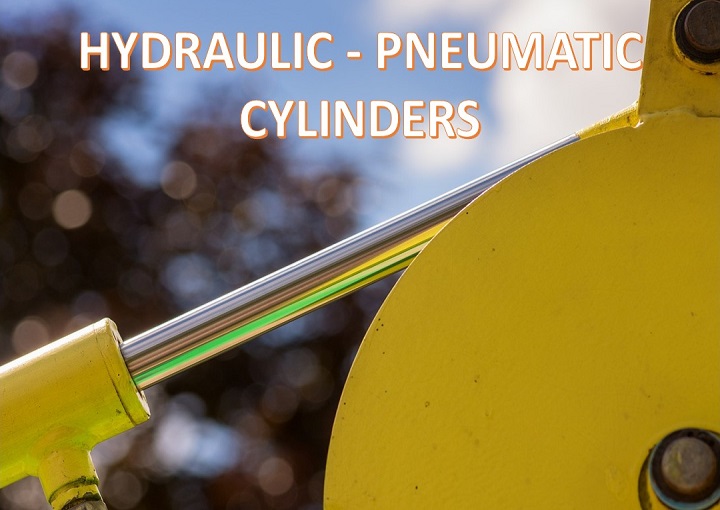Learn about the differences between hydraulic and pneumatic cylinders, their applications, and maintenance tips to keep them working efficiently. Get expert insights on the advantages and disadvantages of each cylinder type and how to maintain them for optimal performance.
Introduction
When it comes to the movement of heavy machinery, hydraulic and pneumatic cylinders play a vital role in different industries. Both hydraulic and pneumatic cylinders use pressurized fluid or gas to generate force and move loads. However, they have some distinct differences that make them suitable for specific applications. In this article, we will discuss the differences between hydraulic and pneumatic cylinders, their applications, and some tips for their maintenance.
Understanding Hydraulic and Pneumatic Cylinders
Hydraulic Cylinders
Hydraulic cylinders use pressurized liquid to generate force and move loads. They are commonly used in construction, mining, agriculture, and transportation industries. Hydraulic cylinders can exert high force due to the incompressibility of liquids. They can operate in harsh environments and extreme temperatures.
How Hydraulic Cylinders Work
Hydraulic cylinders consist of a piston and a cylinder, which is filled with hydraulic fluid. The piston moves inside the cylinder, and the hydraulic fluid is forced through small channels or orifices, generating a force that moves the load. The pressure of the hydraulic fluid determines the force exerted by the cylinder.
Pneumatic Cylinders
Pneumatic cylinders use compressed gas, typically air, to generate force and move loads. They are commonly used in manufacturing, automotive, and packaging industries. Pneumatic cylinders are lighter, cheaper, and easier to maintain than hydraulic cylinders. However, they can only generate limited force.
How Pneumatic Cylinders Work
Pneumatic cylinders consist of a piston and a cylinder, which is filled with compressed gas. The piston moves inside the cylinder, and the compressed gas is forced through small channels or orifices, generating a force that moves the load. The pressure of the compressed gas determines the force exerted by the cylinder.
Applications of Hydraulic and Pneumatic Cylinders
Hydraulic Cylinder Applications
Hydraulic cylinders are commonly used in heavy machinery, such as excavators, bulldozers, cranes, and forklifts. They are also used in hydraulic presses, hydraulic lifts, and hydraulic brakes.
Pneumatic Cylinder Applications
Pneumatic cylinders are commonly used in manufacturing, packaging, and automotive industries. They are used in robotic arms, assembly lines, and automated machinery. Pneumatic cylinders are also used in pneumatic tools, such as drills, hammers, and grinders.
Maintenance Tips for Hydraulic and Pneumatic Cylinders
To ensure the proper functioning of hydraulic and pneumatic cylinders, regular maintenance is necessary. Here are some tips for maintaining hydraulic and pneumatic cylinders:
Hydraulic Cylinder Maintenance Tips
-
- Check the hydraulic fluid level regularly and change it when necessary.
- Inspect the hydraulic hoses and fittings for leaks, cracks, or wear and tear.
- Clean the hydraulic cylinders regularly to prevent dirt and debris from entering the system.
- Check the seals and gaskets for damage and replace them if necessary.
- Lubricate the hydraulic cylinders regularly to prevent corrosion and reduce friction.
Pneumatic Cylinder Maintenance Tips
-
- Check the compressed air supply regularly and ensure that it is free of moisture and contaminants.
- Inspect the pneumatic hoses and fittings for leaks, cracks, or wear and tear.
- Clean the pneumatic cylinders regularly to prevent dirt and debris from entering the system.
- Check the seals and gaskets for damage and replace them if necessary.
- Lubricate the pneumatic cylinders regularly to prevent corrosion and reduce friction.
Conclusion
In conclusion, hydraulic and pneumatic cylinders play a vital role in different industries. While hydraulic cylinders use pressurized liquid to generate force and move loads, pneumatic cylinders use compressed gas. Hydraulic cylinders are suitable for heavy-duty applications where high force is required, while pneumatic cylinders are suitable for light-duty applications where limited force is needed. Regular maintenance is necessary to ensure the proper functioning of both hydraulic and pneumatic cylinders.
By following the maintenance tips outlined in this article, you can keep your hydraulic and pneumatic cylinders working efficiently for a long time. Remember to check the fluid level, inspect the hoses and fittings, clean the cylinders, check the seals and gaskets, and lubricate the cylinders regularly.
If you have any questions or concerns about hydraulic and pneumatic cylinders, feel free to consult a professional. They can provide you with expert advice and guidance on the best practices for maintaining your cylinders.
FAQs
1. What is the main difference between hydraulic and pneumatic cylinders ?
Ans. Hydraulic cylinders use pressurized liquid to generate force, while pneumatic cylinders use compressed gas.
2. What are the applications of hydraulic cylinders?
Ans.Hydraulic cylinders are commonly used in heavy machinery, such as excavators, bulldozers, cranes, and forklifts.
3. What are the applications of pneumatic cylinders?
Ans. Pneumatic cylinders are commonly used in manufacturing, packaging, and automotive industries, as well as in pneumatic tools.
4. Why is regular maintenance necessary for hydraulic and pneumatic cylinders?
Ans. Regular maintenance is necessary to ensure the proper functioning of hydraulic and pneumatic cylinders, and to prevent damage and premature wear.
5. Can I perform maintenance on my hydraulic and pneumatic cylinders myself?
Ans. It’s best to consult a professional for maintenance and repair work on your hydraulic and pneumatic cylinders, as they have the expertise and tools necessary to perform the job safely and effectively.

